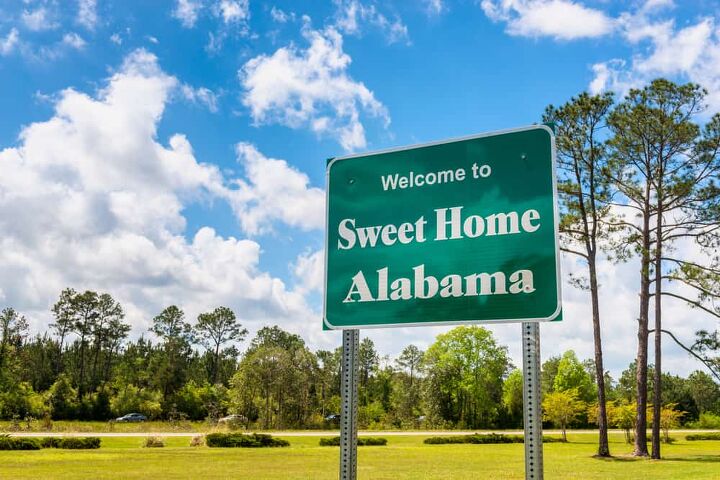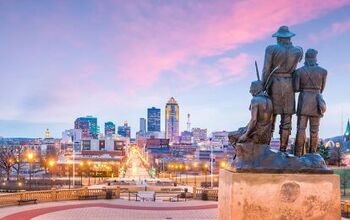What Are The 10 Fastest-Growing Cities In Alabama?

When looking for southern hospitality, it can always be found in Alabama. A friendly face and neighbor will always be available. Beyond that, they offer fantastic food, especially when you want to find a home-cooked meal. Like fried green tomatoes and anything fried smothered in homemade country gravy with a nice glass of sweet tea, some southern delicacies might be the best-tasting food to be made. No wonder people flock to Alabama!
Alabama isn’t usually the first location people think about relocating to; however, it’s booming! We’ve researched the fastest growing cities in this state and have found the top ten for you, starting with Pike Road, with a growth rate of 83.8%, followed by Chelsa (42.3%) and then Fairhope (41.2%) and several others.
If food is not a crucial factor, then the weather may be enough. It is always summer in Alabama. Even in the winter months, cold is considered below 60 degrees, and it may still warm up to 70. This weather makes the scenic environment much more enjoyable. It makes sense why these cities are so popular! Stay tuned while we share a little bit about each one.
Do You Need to Hire Movers?
Get free, zero-commitment quotes from pro contractors near you.

How The Fastest-Growing Cities Were Determined
The census helps to routinely look at population data over a set number of years so that the fastest growing cities can be determined in a simple way. Therefore, we looked at over 100 cities with over 5,000 citizens over the past decade to create this list.
We looked at the population from the prior decade, how many people live there now, and how fast the city is growing during the ten-year period. This is the formula used for the growth rate:
[(Current Population – Previous Population) / Previous Population] x 100
10 Fastest-Growing Cities In Alabama
| City | Previous Population | Current Population | Growth Rate |
| Pike Road | 5,072 | 9,320 | 83.80% |
| Chelsea | 9,202 | 13,098 | 42.30% |
| Fairhope | 14,927 | 21,083 | 41.20% |
| Foley | 13,570 | 18,533 | 36.60% |
| Gulf Shores | 9,035 | 12,267 | 35.80% |
| Calera | 10,374 | 13,856 | 33.60% |
| Spanish Fort | 6,624 | 8,601 | 29.80% |
| Robertsdale | 5,052 | 6,473 | 28.10% |
| Wetumpka | 6,480 | 8,243 | 27.20% |
| Auburn | 51,057 | 64,054 | 25.50% |
1. Pike Road
- Current Population: 9,320
- Previous Population: 5,072
- Growth Rate: 83.8%
It is no surprise that a town like Pike Road is at the top of this list, especially when considering its history of economic and community growth over the years. The area was settled in the early 1800s, and as farming communities expanded toward an intersection of two roads, this town started to evolve.
By the mid-1900s, the area had grown so much that a school was a necessity. As the area continued to grow, the debate of incorporating the town grew as well. Finally, in the late 1990s, it was decided that the communities of Glynlakes, Bean, Barnes, and Meriwether Road would be incorporated as the city of Pike Road. Today Pike Road is constantly growing to meet the needs of its residents.
2. Chelsea
- Current Population: 13,098
- Previous Population: 9,202
- Growth Rate: 42.3%
Melrose was the name residents used for this community up until the early 1900s. During that time, the railroad made its tracks through the area, and more communities started to settle in the land. Railroad officials then renamed the area Chelsea due to another community named Melrose already established on the route.
This new community of Chelsea included stores, a grain mill, and a sawmill. When the town was incorporated in 1996, it had a population of a little more than 900. Real estate development in the county started moving more south from Birmingham, and the town’s population and the economy boomed ever since.
Chelsea has a vast park that consists of soccer fields, three baseball fields, and a walking trail. Because the park is roughly 29 acres, there is so much more that can be found there. There are over 200 homes built every year to accommodate the increase in population.
3. Fairhope
- Current Population: 21,083
- Previous Population: 14,927
- Growth Rate: 41.2%
This city was the foundation of a group of reformers’ dreams. They sought their utopia based on Henry George’s Single Tax philosophy, a solution to economic and social issues in that time period. They found an area on the eastern shore of Mobile Bay and believed using the single tax thought would give them “fair hope” in achieving their dreams. This attracted enthusiasts from all over the country to the area.
In 1908 the town was established with a population of 500. Over the years, it became a proprietor of parks, including Knoll Park and Henry George Park. It has always been a resort community for nearby residents, but its serene environments and motivating landscape have attracted more than just tourists. Artists and writers alike have used Fairhope as a safe place for their art, and the community would not be what it is today without its residents.
4. Foley
- Current Population: 18,533
- Previous Population: 13,570
- Growth Rate: 36.6%
Foley, Alabama, knows what hard work and determination can bring to a city. Back in 1901, John Foley bought between forty to fifty thousand acres of land. He used his own money to build a railroad to the town, and the first train station was built in 1905. He donated land so the community could build schools, parks, and churches.
Foley was predominantly a farming community and supplied goods, particularly potatoes, to neighboring communities. Today the town focuses on retail and art culture. Every November, they hold Heritage Harbor Days that last for three days. This includes live entertainment and a 28-foot shrimp boat that takes Foley’s culture and heritage to another city to share.
5. Gulf Shores
- Current Population: 12,267
- Previous Population: 9,035
- Growth Rate: 35.8%
Located in the Gulf of Mexico, this little city is considered a resort city that caters to tourists and residents. It is the southernmost community in the state of Alabama and experiences long, hot summers and mild, warm winters. Residents were initially attracted to the area in the late 1930s with the completion of the Intercoastal Waterways and Gulf State Park opening. Before then, it was a desolate area with a small fishing community.
The town offers employment for shrimping and fishing, and the community arranged National Shrimp Festival that attracts almost 200,000 people in October. A large portion of the population is considered “snowbirds,” but the city’s development makes it harder for residents to leave.
6. Calera
- Current Population: 13,856
- Previous Population: 10,374
- Growth Rate: 33.6%
This town thrived on a calcium-based mineral called Lime. The name of the town has changed multiple times. It was known initially as Buxahatchie, but people referred to it as Limeville, Lime City, and Lime Station, based on the amount of lime produced from the area after the Civil War. Since the town suffered little to no damage during the Civil War, it was able to resume lime production quickly, and in 1869 the city was officially named Calera, a Spanish word for “lime.”
The city remains a producer of lime but has been identified as an ideal place for other industrial corporations. Once SYSCO, a wholesale restaurant food supplier, moved to Calera, other businesses began to flourish. The community compliments this with large farmers’ markets and festivals throughout the summer months. A town labeled as the “Heart of the Heart of Dixie” is a small town but offers residents so much more.
7. Spanish Fort
- Current Population: 8,601
- Previous Population: 6,624
- Growth Rate: 29.8%
This little town has a history that dates back to the early 1700s, when the site was created as a trading post. The area was fought over for many years, control changing from French to British to the Spanish. During the American Civil War, multiple other forts and defenses were created to protect the city of Mobile. In 1865, Union troops seized control of the Spanish Fort, which supported them to demolish the last opposition east of the Mississippi River.
Spanish Fort is a community that is dedicated to growth and new development. The city protects its natural resources while making outdoor activities available. It is a diverse community that has sustained a small-town scene.
8. Robertsdale
- Current Population: 6,473
- Previous Population: 5,052
- Growth Rate: 28.1%
Founded in 1905 after establishing the Louisville and Nashville Railroad, the town was named after an official, B.F. Roberts, of The Southern Plantation Development Corporation. The original industries for the economy at the time were based on agriculture and timber.
Robertsdale is the hometown of Tim Cook, CEO of Apple Inc, and maintains a hometown atmosphere. There are plenty of public parks and outdoor activity opportunities. Being considered a safe town is one reason many people move here to raise their families.
9. Wetumpka
- Current Population: 8,243
- Previous Population: 6,480
- Growth Rate: 27.2%
The name is derived from the original habitants, the Muscogee people, who had a saying “we-wau tum-cau,” which means “rumbling waters.” This is believed to be from the Coosa River, which rapids could be heard for miles up until the dam was built. Wetumpka is built around the river. After the Muscogee people were forced from their land, under the Indian Removal Act of 1830, the area saw a lot of war and hardship.
Even though the town had a rough start, Wetumpka is defined as “The City of Natural Beauty.” Today the town host various events that include sporting events, like mountain bike races and whitewater festivals. There is also an outdoor museum, Jasmine Hill Gardens, that was built in 1930 and was dedicated to replicating Greek culture. With new construction and businesses taking shape, the town has grown and flourished.
Do You Need to Hire Movers?
Get free, zero-commitment quotes from pro contractors near you.

10. Auburn
- Current Population: 64,054
- Previous Population: 51,057
- Growth Rate: 25.5%
Auburn is the largest city in eastern Alabama and has the nickname “The Loveliest Village on the Plains.” It is home to Auburn University, which opened in 1859, shortly after its incorporation in 1839. The town’s economy suffered depression during the Civil War, schools and businesses were closed for more than ten years, and residents left the area.
In 1892, Auburn University became the first college in Alabama to accept women as students. Over the years, Auburn became known as a historic college town, and even their public school system is considered the top not only in the state but in the nation. With education reporting the town as one of the best, thousands of citizens moved to Auburn.
The city also pursued industries to move to the area, which increased job availability. This town has so much going on and benefits for its residents; it was no wonder in 2009, the U.S. News listed it among the top ten best places to live.
More Related Guides

Heather is a passionate writer who loves anything DIY. Growing up, she learned everything from home repairs to design, and wants to share her tips with you. When she's not writing, she's usually hiking or searching for her next DIY project.
More by Heather Robbins


















![Cost To Drill A Well [Pricing Per Foot & Cost By State]](https://cdn-fastly.upgradedhome.com/media/2023/07/31/9074980/cost-to-drill-a-well-pricing-per-foot-cost-by-state.jpg?size=350x220)








